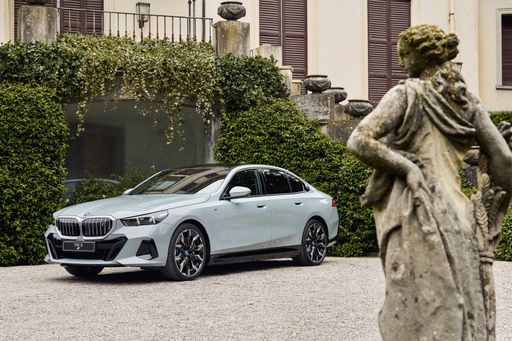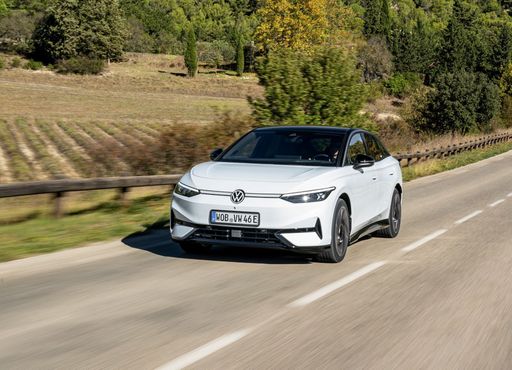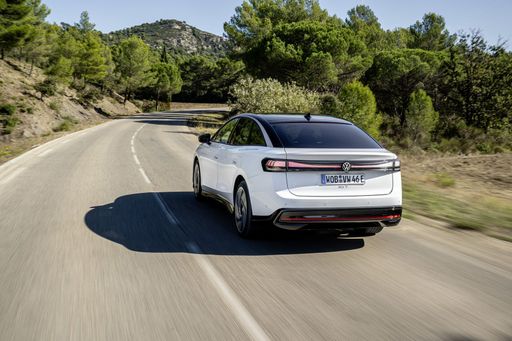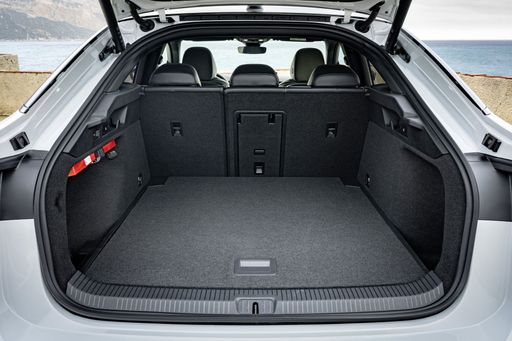BMW i5 vs VW ID.7 – Which model is better for everyday use?
Compare performance, boot capacity, efficiency and price at a glance.
Find out which car is the better choice for you – BMW i5 or VW ID.7?
Costs and Efficiency:
Looking at overall running costs, both models reveal some interesting differences in everyday economy.
VW ID.7 has a distinct advantage in terms of price – it starts at 46400 £, while the BMW i5 costs 60200 £. That’s a price difference of around 13796 £.
In terms of energy consumption, the advantage goes to the VW ID.7: with 13.60 kWh per 100 km, it’s barely noticeable more efficient than the BMW i5 with 14.70 kWh. That’s a difference of about 1.10 kWh.
As for range, the VW ID.7 performs a bit better – achieving up to 708 km, about 81 km more than the BMW i5.
Engine and Performance:
Power, torque and acceleration are the classic benchmarks for car enthusiasts – and here, some clear differences start to show.
When it comes to engine power, the BMW i5 has a significantly edge – offering 601 HP compared to 340 HP. That’s roughly 261 HP more horsepower.
In acceleration from 0 to 100 km/h, the BMW i5 is decisively quicker – completing the sprint in 3.80 s, while the VW ID.7 takes 5.40 s. That’s about 1.60 s faster.
In terms of top speed, the BMW i5 performs distinct better – reaching 230 km/h, while the VW ID.7 tops out at 180 km/h. The difference is around 50 km/h.
There’s also a difference in torque: BMW i5 pulls a bit stronger with 820 Nm compared to 679 Nm. That’s about 141 Nm difference.
Space and Everyday Use:
Cabin size, boot volume and payload all play a role in everyday practicality. Here, comfort and flexibility make the difference.
Both vehicles offer seating for 5 people.
In curb weight, VW ID.7 is barely noticeable lighter – 2180 kg compared to 2195 kg. The difference is around 15 kg.
In terms of boot space, the VW ID.7 offers slight more room – 532 L compared to 490 L. That’s a difference of about 42 L.
When it comes to payload, BMW i5 to a small extent takes the win – 545 kg compared to 465 kg. That’s a difference of about 80 kg.
Who comes out on top?
Overall, the BMW i5 shows itself to be outperforms in nearly all aspects and secures the title of DriveDuel Champion.
It convinces with the more balanced overall package and proves to be the more versatile choice for everyday use.

BMW i5
BMW i5
The sleek new i5 captivates drivers with its striking design and innovative features that blend luxury and efficiency. Inside, the spacious cabin boasts cutting-edge technology, ensuring a connected and comfortable ride for all passengers. Whether navigating city streets or embarking on a weekend getaway, the i5 delivers a dynamic driving experience that is sure to impress.
details @ BMW
@ BMW
 @ BMW
@ BMW
 @ BMW
@ BMW
VW ID.7
The VW ID.7 represents a significant step forward in Volkswagen's electric vehicle lineup, offering an elegant design combined with advanced technology features. This electric saloon showcases a sleek aerodynamic profile, prioritising both performance and efficiency. Inside, drivers will appreciate the spacious and modern cabin, equipped with intuitive controls and connectivity features for a seamless driving experience.
details @ Volkswagen.de
@ Volkswagen.de
 @ Volkswagen.de
@ Volkswagen.de
 @ Volkswagen.de
@ Volkswagen.de
 @ Volkswagen.de
@ Volkswagen.de

|

|
|
|
|
Costs and Consumption |
|
|---|---|
|
Price
60200 - 85300 £
|
Price
46400 - 54200 £
|
|
Consumption L/100km
-
|
Consumption L/100km
-
|
|
Consumption kWh/100km
14.7 - 17.1 kWh
|
Consumption kWh/100km
13.6 - 16.2 kWh
|
|
Electric Range
540 - 627 km
|
Electric Range
594 - 708 km
|
|
Battery Capacity
81.20 kWh
|
Battery Capacity
77 - 86 kWh
|
|
co2
0 g/km
|
co2
0 g/km
|
|
Fuel tank capacity
-
|
Fuel tank capacity
-
|
Dimensions and Body |
|
|---|---|
|
Body Type
Sedan
|
Body Type
Hatchback
|
|
Seats
5
|
Seats
5
|
|
Doors
4
|
Doors
5
|
|
Curb weight
2195 - 2370 kg
|
Curb weight
2180 - 2325 kg
|
|
Trunk capacity
490 L
|
Trunk capacity
532 L
|
|
Length
5060 mm
|
Length
4961 mm
|
|
Width
1900 mm
|
Width
1862 mm
|
|
Height
1505 - 1515 mm
|
Height
1535 - 1536 mm
|
|
Max trunk capacity
-
|
Max trunk capacity
1586 L
|
|
Payload
525 - 545 kg
|
Payload
460 - 465 kg
|
Engine and Performance |
|
|---|---|
|
Engine Type
Electric
|
Engine Type
Electric
|
|
Transmission
Automatic
|
Transmission
Automatic
|
|
Transmission Detail
Reduction Gearbox
|
Transmission Detail
Reduction Gearbox
|
|
Drive Type
Rear-Wheel Drive, All-Wheel Drive
|
Drive Type
Rear-Wheel Drive, All-Wheel Drive
|
|
Power HP
340 - 601 HP
|
Power HP
286 - 340 HP
|
|
Acceleration 0-100km/h
3.8 - 6 s
|
Acceleration 0-100km/h
5.4 - 6.6 s
|
|
Max Speed
193 - 230 km/h
|
Max Speed
180 km/h
|
|
Torque
430 - 820 Nm
|
Torque
545 - 679 Nm
|
|
Number of Cylinders
-
|
Number of Cylinders
-
|
|
Power kW
250 - 442 kW
|
Power kW
210 - 250 kW
|
|
Engine capacity
-
|
Engine capacity
-
|
General |
|
|---|---|
|
Model Year
2023 - 2024
|
Model Year
2023 - 2024
|
|
CO2 Efficiency Class
A
|
CO2 Efficiency Class
A
|
|
Brand
BMW
|
Brand
VW
|
What drive types are available for the BMW i5?
The BMW i5 is offered with Rear-Wheel Drive or All-Wheel Drive.
The prices and data displayed are estimates based on German list prices and may vary by country. This information is not legally binding.
